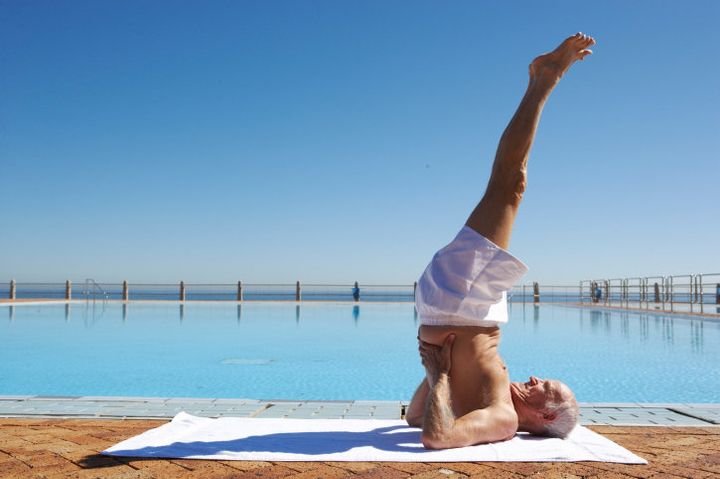
"Blue zones" describe a handful of longevity hot spots around the world, where people commonly live active and healthy lives past the age of 100. With a lifespan 10 years longer than the average American, the typical Blue Zone dweller survives into his/her twilight years relatively unscathed by cancer, heart disease and dementia. Just as remarkably, these sprightly centenarians don't just stagger over the 100-year mark, they charge heartily through the other side, plowing through the winter of life with verve, a bag of homespun rock salt, and a determination to manifest the spring. The TED Talk on Blue Zones showcases their legendary vigor in clips of gritty seniors riding motorbikes and horses, arm-wrestling, volunteering in their communities, building fences and performing open-heart surgery! So how is it that these old folk trick the 35 trillion cells in their bodies into degenerating more slowly than the rest of humanity? Is there an underlying code across these communities that may be prescribed to extend our own lives?
On the surface, the Blue Zones could not be more dissimilar. The five geographies recognized as such are each stamped with ironclad traditions, eclectic living habits and social priorities, along with a distinguished blend of local environment and gene pool. Contrast a Blue Zone pocket tucked away in the Sardinia highlands, featuring a diet based on cheese from grass-fed animals, unleavened whole wheat bread and a high polyphenol-content local wine, with a wellness cluster in Okinawa boasting a plant-based, tofu-laced diet served up on micro-sized plateware. How can we possibly find a wellness correlation across such vastly different worlds as Italy and Japan?
Stir into this veritable stew of multicultural wellness the Grecians of Ikaria, with their blood pressure-reducing herbal teas, and the Nicoya, Costa Ricans with their mesoAmerican beans-based diet. The diversity of practices, lifestyles and ethnicities seems to frustrate any hope for a neatly franchisable five-step plan to break the 100-year barrier.
Dan Buettner, a National Geographic journalist and champion of Blue Zones, makes the case that in fact there is a collective intelligence that converges around how these communities eat, live and interrelate. Buettner and a team of scientists have found over time that there are lessons to be teased out of such diversity. The Blue Zone citizens all move their bodies regularly, they have built ingrained social rituals that create space to decompress and downshift regularly, they have developed the intellectual constructs and vocabulary to articulate purpose in life (see the concept of ikigai, literally translated as "what gets you up in the morning" from Okinawa). Across the groups, they also eat wisely (a combination of local wine, plant-rich diets and moderate portions); with age, they become the veritable rock stars of their communities, accumulating social capital and perpetuating a sense of belonging and connection with their respective tribes.
Mining the collective intelligence of hyper-healthy micro-communities for transportable lessons in wellness is also the foundation of YogaEarth, a nutrition company I founded to tap into the rich knowledge base of yoga teachers in mind-body wellness.
Yogis are among the most strident advocates of pure, healthy foods. YogaEarth recruits large communities of incredibly diverse teachers to collaborate in product design and field-testing, pooling their ideas, experiences and preferences to build best-in-class mind-body nutrition.
We are often asked how we can possibly find any coherent ideas for nutrition from such a divergent, independently-minded community. What lessons can we possibly salvage from this fragmented bounty of voices, disciplines and philosophies? If you think the cultural breach between Italy and Japan is vast, try Kundalini and Bikram.
Much as in the case of Blue Zones, there is a quietly hidden coherence in yoga wellness residing beneath the jumbled, oftentimes noisy mash of ideas, experiences and beliefs. The journey to find this coherence is not at all times direct, sometimes it is frustrating, and in my experience it almost always possesses an elegant simplicity. Both these exceptional geographies, and the discrete teachings of hundreds of schools of yoga possess an instructive core and yield valuable lessons in the pursuit of wellness. Observe the spaces between these places, cultures and experiences and we will find a deep stream of knowledge that may help us live longer and better.
This is not to suggest a free-for-all of indiscriminately selected health and wellness truths. The study of Blue Zones has its scientific and multi-disciplinary rigor, and at YogaEarth we have ours, both based on years of technical experience and training. This is a suggestion that it may be worthwhile to get beyond our own experience and deep worn patterns of living. Where can we unearth unexpected lessons for living healthier and happier? Are we receptive to this exploratory process of the diversity of human practice, whether it comes from micro-cultures dotting the globe, from a range of distinctive yoga communities spanning the country, or perhaps from another unexpected source? If it's true that 75-90 percent of longevity is dictated by lifestyle versus genes, this is a worthwhile journey for all of us to consider.